In a 2021 survey, 66% of decision-makers reported a boom in thought leadership content spurred by the pandemic. Today, the phrase has become an industry buzzword. Still, when done right, the content style builds awareness and positions brands as industry experts.
If you’re contemplating incorporating thought leadership into your content marketing strategy, you’re not too late. We’ll explain what good thought leadership is, when it’s worth using, and how to create solid thought leadership content. Then we’ll share some examples to inspire you.
What is thought leadership content?
Thought leadership content refers to unique opinion or viewpoint pieces—created by subject matter experts—that inform, educate, or entertain.
It differs from average search engine optimized (SEO) content because its purpose isn’t to promote the brand, sell to readers, or appease search engines. Instead, it’s purely informational.
Good thought leadership content should do these two things:
Take a stand
The point of thought leadership is to share a valuable opinion. 64% of respondents to SurveyMonkey’s Thought Leadership Report said that they expect thought leadership content to “challenge the way they think.”
Your thought leadership pieces should choose a side by sharing a personal story or a unique line of thought. It shows readers that you (and, by extension, your company) aren’t afraid to stand for your values.
David Ramos, senior SEO analyst at AAA agrees. He says:
Thought leadership pieces should never be afraid to lean into an opinion, even a controversial one. Use it to draw in your target audience and repel everyone else.David Ramos
SEO & Content Strategist at AAA
Be audience-serving
Good thought leadership content should empower your audience.
Granted, all good content should empower your audience. However, unlike most case studies, white papers, and SEO blogs that are only written with data in mind, thought leadership content also empowers your audience emotionally. It’s based on personal experience and expertise, which are powerful tools for both connection and forward thought.
Another distinguishing facet of thought leadership content is that it is not self-serving. According to Ann Smith, content marketing consultant at Conviva:
This is a mistake many marketers make when devising thought-leadership strategies. They write stories that are thinly disguised sales pitches and the media sees right through.Ann Smith
Content marketing consultant at Conviva
Individual-led content provides value to your audience without directly promoting your brand or product. It’s a hallmark of fine thought leadership content.
When should you use thought leadership content?
Like most types of content, thought leadership doesn’t work for every situation. Here are three business goals that lend themselves well to this kind of content.
Build trust and credibility
Thought leadership content effectively creates brand awareness by fostering trust and credibility with your target audience.
Expert content is easily recognizable and often respected by industry peers. Your audience relies on you for tested and true material, and they can be certain that there are no “ulterior motives” since you aren’t trying to sell them anything.
Once the benefits of thought leadership start to come in, they compound quickly. They can benefit a brand for years as the content is cited in other industry blogs and referred to in social media content—further cementing your position as a field expert.
Connect with your audience
Thought leadership content makes it easier to connect with your audience, especially when you put a face to your content’s authors. As much as people trust brands, it’s easier to form human-to-human connections.
Make your company more approachable by writing content that includes your founder and team members’ expertise. When customers see bylined content from in-house sources, they’re likely to associate the expertise with your company. They’ll view your founder or team members as people with the solutions to their pain points.
Writer and content strategist Sofie Couwenbergh agrees that thought leadership with visible authorship builds strong connections, particularly when experts take a stand. She says:
Speaking in favor of or against something is a powerful way to build connections; you can attract people who feel the same way and build a loyal community.Sofie Couwenbergh
Content strategy and SEO content writing for B2B brands in digital marketing
Tackle industry topics that aren’t SEO keyword-based
As much as we appreciate the power of SEO, a low keyword volume doesn’t necessarily mean that your topic of choice has no audience.
Thought leadership content is perfect for delving into such topics. After all, 71% of decision-makers read thought leadership pieces to help them develop new ideas—not to find yet another article on overly dissected SEO topics.



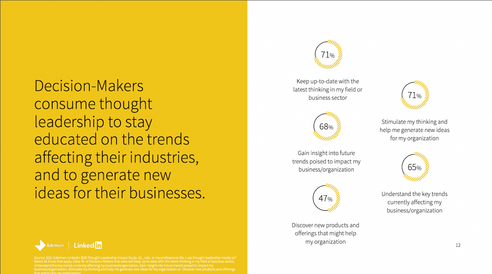
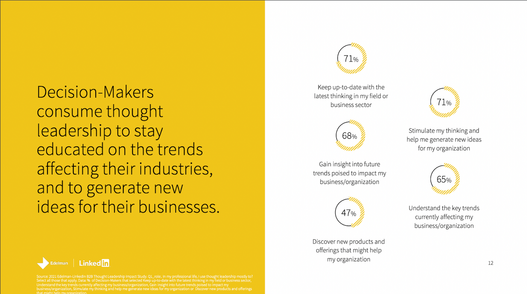
 We recommend thought leadership content if you’re ready to try using other content performance metrics besides search engine rankings.
We recommend thought leadership content if you’re ready to try using other content performance metrics besides search engine rankings.
How to create brilliant thought leadership content
Creating content that resonates is no easy feat. These four tips make the process less tedious and more enjoyable.
Choose the right topic
Despite the vast range of options available, 71% of executives say that less than half of the thought leadership they consume gives them valuable insights. Avoid falling into the less useful 50% by selecting a topic that matters to your audience—not just to you.
Ask yourself the following questions when deciding on a topic for your piece:
- Will my audience care about this topic? Why?
- What’s unique about my angle and why will it appeal to my audience?
- Is my topic a trending issue? If so, how do I include a unique perspective and avoid fatiguing my audience?
Manpreet Kaur, branding and thought leadership lead at Leena AI agrees. She says:
Choose a topic your audience can relate to, draw meaningful insights from, and utilize extensively for their businesses.Manpreet Kaur
Branding & Thought Leadership at Leena AI
However, this means you need to know your audience well.
Building audience personas, running surveys, and doing some social listening are all great ways to learn more about your audience’s needs. You can then use this information to create thought leadership content attuned to them.
Write from an expert point of view
68% of respondents to SurveyMonkey’s Thought Leadership report agree that true thought leaders have expert knowledge. Thought leaders share fresh, stand-out insights gleaned from hands-on experience in a certain industry.
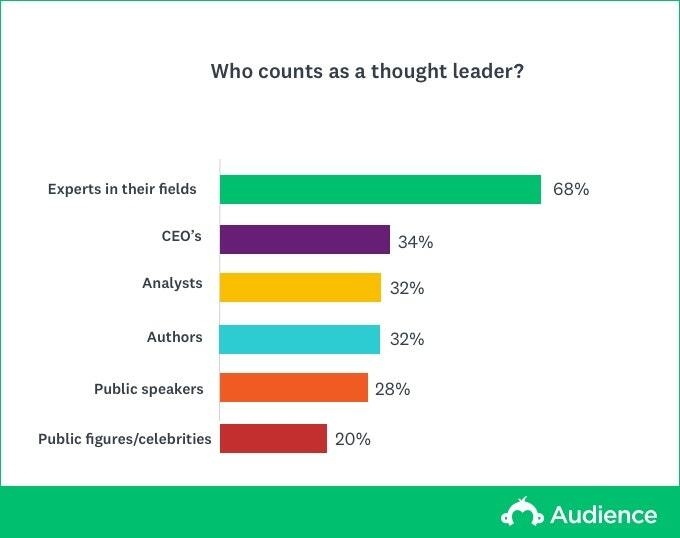
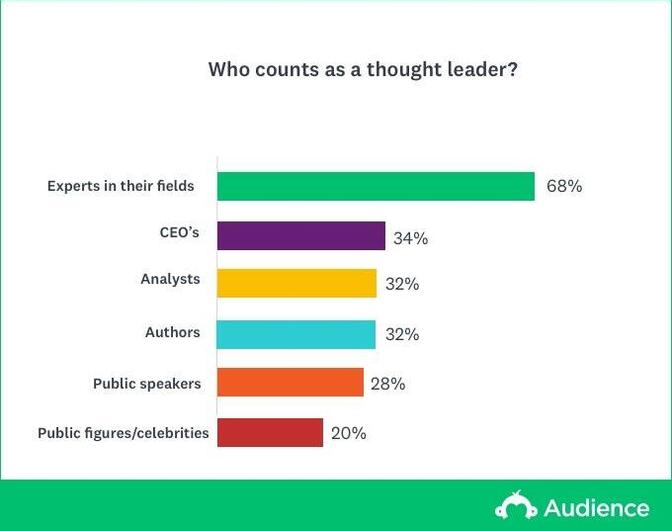
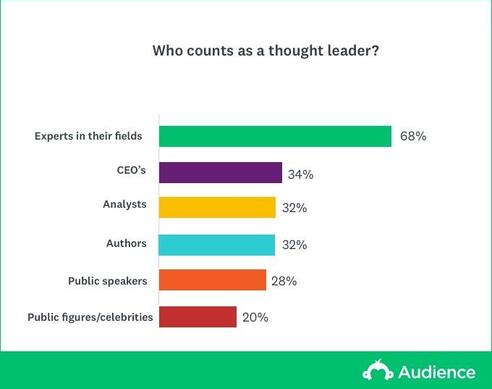
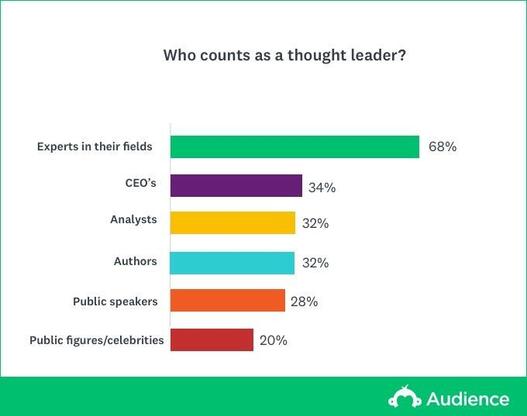
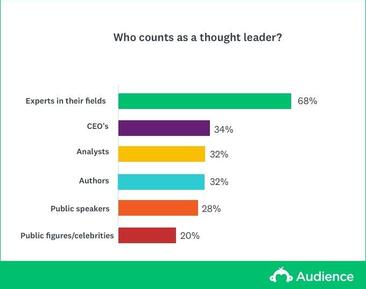
Ann Smith agrees. She defines “expert” as:
Someone who is credible by way of their experience with the subject matter and/or they have data to back up what they’re saying.
While there’s no specific number of years necessary to gain the expert badge, expertise means you don’t need to look up a topic to talk about it.
If you’re working outside your area of expertise, you can only create rich thought leadership content by gathering insights from an expert. One way to do this is by interviewing multiple subject matter experts in your network.
Be consistent
Brand consistency is essential to creating exceptional thought leadership content. As thought leadership helps more people see what your brand stands for, it’s vital to consistently reflect the same values in every piece of content you create.
For example, let’s say your company is passionate about climate change and regularly discusses the issue in its thought leadership content. Then, you should also be able to show readers how your operations support those values—like reducing your carbon footprint or offsetting its impact.
This reinforces the trustworthiness of your brand and solidifies the positive image you’re working to build.
On the other hand, if your content showcases inconsistent values, it defeats the essence of thought leadership content.
Align with your business goals
The best thought leaders have figured out how to serve their audience while remaining aligned with their business goals.
Although thought leadership content may not result directly in conversions, it helps your company attain other key performance metrics:
- Increased traffic to your blog
- Additional backlinks from media outlets
- Expanded social media following
Your content strategy will depend heavily on whether you want to gain traffic, improve your website’s authority, or create brand awareness in the industry and on social media. Investing in SEO content and thought leadership content to create a well-rounded strategy is worthwhile.
5 thought leadership content examples to learn from
Many B2B blogs share a mix of thought leadership and SEO content, so we’ve rounded up five examples of thought leadership pieces from the brands below.
SparkToro: Provable Marketing Attribution is a Boondoggle; Trust Your Gut Instead
This post by Rand Fishkin of SparkToro is a prime example of thought leadership content. There’s no obvious SEO keyword or promotional call-to-action, but the article is packed with value.
Fishkin is a marketing expert pitching a tip contrary to traditional marketing advice. The piece also shows SparkToro’s values as the company engages in unconventional marketing styles—including their blog, which is primarily thought leadership content.
Float: Why Leaders Should Embrace an Asychronous Work Culture
Written by Float’s CEO & Co-Founder Glenn Rogers, this post puts a personal, expert spin on a popular subject.
Instead using optimized subheadings and a writing how-to list for adapting asynchronous work culture, Rogers shares the steps he and his co-founder took to build an async, remote company. Like all true thought leaders, he gives readers a peek into his company’s values without asking anything from them at the end of the piece.
Hotjar: Why Companies Should Be Investing in Leadership Coaching
This Hotjar piece speaks to a broad segment of the company’s audience: marketing and analytics teams at large corporations.
The article’s byline is Imran Omari, internal expert who has undergone leadership coaching and can speak credibly to its benefits. Hotjar’s only call-to-action benefits their audience by asking them to join their company.
Slite: 'People first' only goes so far for parents
Slite serves remote teams, and the company’s blog is chock-full of thought leadership content like this blog post. It discusses how remote work impacts parenting.
The post is written by an expert—in this case, a parent on the Slite team. It has zero directly promotional content. Instead, it focuses on educating and entertaining its readers.
ProfitWell: How Skype blew a 10-year lead to Zoom
This ProfitWell article shows another thought leadership content angle: industry trends. The contributor explores the rise of the video-conferencing tool, Zoom, and how it usurped Skype’s position during the COVID-19 pandemic.
It’s full of refreshingly unique insights. Lastly, it only asks that readers share the piece on social media if they enjoyed it.
Build exceptional thought leadership content with Bynder’s Content Workflow
Building a high-quality content library is a long-term game—especially if you’re focusing on thought leadership marketing. But it's possible to succeed with the right topic, experts, and consistency.
No matter what type of content you choose to market your brand, you’ll need a content marketing platform to make the task easier. That’s where we come in. Bynder’s Content Workflow is an all-in-one content operations platform with a host of marketing use cases. Our features allow you to plan, write, edit, and publish your big ideas without switching platforms.
Do you want to see how it works? Try Content Workflow.









